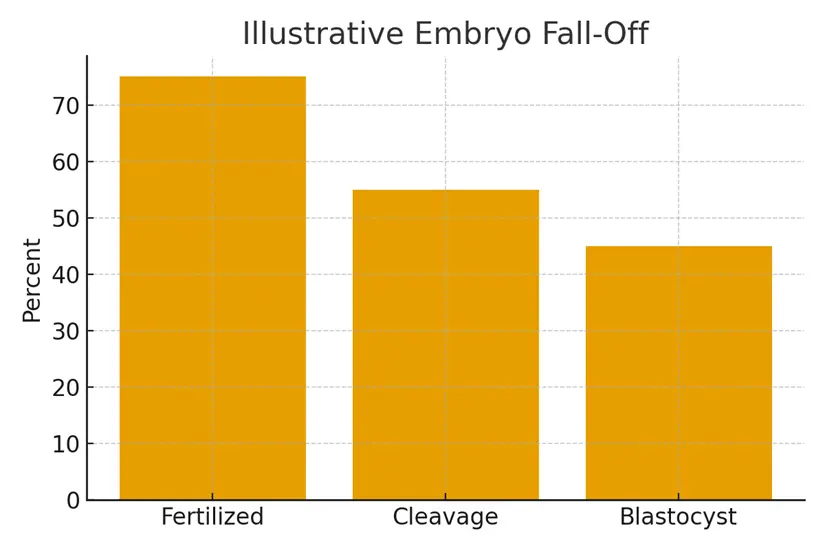
When starting your IVF (In Vitro Fertilization) journey, one of the first questions that comes to mind is — what are my chances of success? IVF success rates depend on multiple factors, from your age and egg quality to lab efficiency, embryo testing, and timing precision. This guide explains the core elements that influence IVF outcomes and how intended parents can make informed, confident decisions.
At Surrogacy4All, we believe that understanding IVF success rates begins with education. The more clarity you have about the process, the more empowered you are to manage expectations, plan budgets, and protect emotional well-being throughout your journey.
Understanding IVF Success Rates
IVF success rates are often reported as the percentage of live births per embryo transfer or per cycle started. However, these numbers vary widely depending on several biological, procedural and lifestyle factors.
What “Success” Really Means
Success in IVF is not limited to a single embryo transfer. Many families achieve pregnancy over multiple cycles — what matters most is the cumulative success rate. A single cycle may not guarantee pregnancy, but strategic planning over two or three cycles significantly raises your odds.
PGT-A Basics for Intended Parents
Preimplantation Genetic Testing for Aneuploidy (PGT-A) is one of the most discussed tools in IVF today. It helps identify embryos with the correct number of chromosomes, improving the chances of selecting a healthy embryo for transfer.
Where PGT-A Fits in Your IVF Journey
PGT-A takes place after fertilization but before embryo transfer. The embryo is biopsied, and cells are analyzed for chromosomal abnormalities. This information allows your care team to prioritize embryos most likely to implant successfully.
Who Benefits Most from PGT-A
PGT-A can be especially beneficial for:
- Women over 35, where the risk of chromosomal errors is higher.
- Intended parents with recurrent miscarriages.
- Couples using donor eggs or sperm.
- Families seeking single-embryo transfer to reduce multiple risks.
PGT-A does not guarantee a successful pregnancy. The PGT-A can guide you in making decisions. Still, it cannot change your biological limitations, such as the quality of your sperm or eggs.
Factors That Influence IVF Success Rates
Age and Egg Quality
Age remains the most significant factor. Women under 35 typically have a higher chance of pregnancy per cycle than those over 40. This is because egg quality — and therefore embryo quality — naturally declines with age.
Embryo Quality and Euploidy
The genetic health of embryos (euploidy rate) drives implantation success. Here, pharmacy logistics plays a hidden yet crucial role — ensuring medications and hormonal timing align perfectly improves egg maturity and embryo quality.
Endometrial-Embryo Timing Match
A strong correlation exists between the uterine environment and implantation success. Endometrial-embryo timing match — where the embryo is transferred when the endometrium is most receptive — can increase pregnancy odds significantly.
Clinic Experience and Laboratory Standards
Not all IVF clinics operate with the same precision. Success rates improve when the clinic’s embryology lab maintains strict standards for culture conditions, embryo freezing and thawing processes.
Emotional and Logistical Simplicity
The clinical team at Surrogacy4All emphasizes that simplicity and timing protection improve outcomes.
Expert Quote:
“Protect timing and keep plans simple—quality improves when noise goes down.” — Clinical Team
Costs and Realistic Budget Planning
Understanding costs upfront helps reduce stress during treatment. IVF costs vary depending on medications, genetic testing and the number of cycles required.
Typical IVF Cost Breakdown
- Ovarian Stimulation & Medication: 30–40% of total cost.
- Egg Retrieval & Anesthesia: 20–25%.
- Embryo Culture & PGT-A Testing: 15–20%.
- Frozen Embryo Transfer (FET): 10–15%.
- Miscellaneous (consultations, monitoring, storage): 10%.
Transparent pricing and scenario planning simplify budgeting and prevent surprises — as noted by patients who valued cost clarity.
“Costs were clear; no surprise bills.” — L., Hoboken
The Patient Journey — From Uncertainty to Clarity
Every intended parent’s IVF path looks different. For example, a couple struggling with failed cycles found clarity once they understood where delays and mismatches occurred.
By aligning logistics, expectations and medical guidance, they improved both predictability and outcomes. Their journey demonstrates how knowledge empowers patients to manage their own care.
“The steps finally made sense.” — A.&J., Manhattan
“Nurses replied fast with practical coaching.” — K.&V., Queens
What You Can Control vs What You Monitor
You Control:
- Lifestyle: Nutrition, rest, and managing stress.
- Compliance: Following medication schedules and clinic instructions.
- Communication: Keeping your clinic informed about any changes.
You Monitor:
- Embryo development: Determined by lab and biological quality.
- Genetic health: Assessed through PGT-A.
- Endometrial response: Evaluated by your medical team before transfer.
Frequently Asked Questions:-
Q: Is this medical advice?
A: No — this information is educational. Always use it to guide deeper conversations with your fertility clinic.
Q: How many cycles should I plan?
A: Think in ranges. Most intended parents see success after two to three cycles. Cumulative success rates offer a more realistic outlook.
Q: What drives cost most?
A: Medications, genetic testing, anesthesia, and the total number of cycles contribute most to your budget.
Final Insight
Genetic testing decisions, when combined with pharmacy coordination and precise timing, improve IVF predictability. While not every step guarantees success, protecting timing, simplifying logistics and maintaining transparency always lead to better outcomes — medically, emotionally and financially.
Taking the Next Step with Surrogacy4All
Your IVF success depends on informed decisions, consistent timing, and compassionate support.
- Free 15-minute nurse consult at (212) 661-7673
- Upload your labs for a second opinion.
- Request a personalized cost breakdown for your case.
At Surrogacy4All, we simplify complex fertility journeys with transparency, evidence-based guidance, and emotional support. Every step is designed to make your path toward parenthood more predictable and humane.

Dr. Kulsoom Baloch
Dr. Kulsoom Baloch is a dedicated donor coordinator at Egg Donors, leveraging her extensive background in medicine and public health. She holds an MBBS from Ziauddin University, Pakistan, and an MPH from Hofstra University, New York. With three years of clinical experience at prominent hospitals in Karachi, Pakistan, Dr. Baloch has honed her skills in patient care and medical research.




